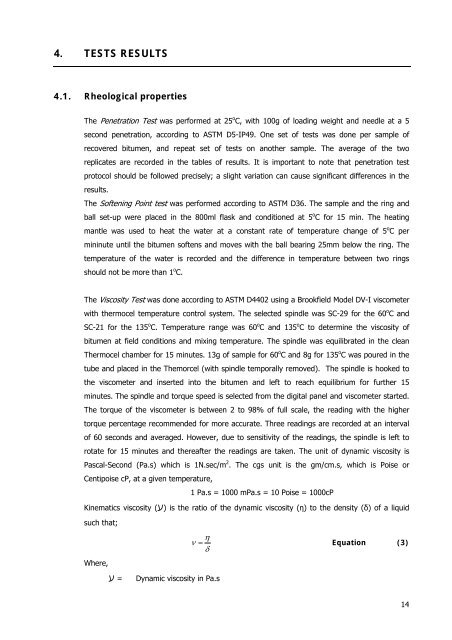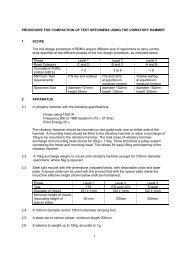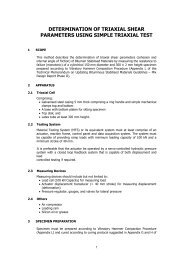Updating Bituminous Stabilized Materials Guidelines Mix Design Report Phase II
Task 11: Durability: Ageing of bituminous binder - Asphalt Academy
Task 11: Durability: Ageing of bituminous binder - Asphalt Academy
Create successful ePaper yourself
Turn your PDF publications into a flip-book with our unique Google optimized e-Paper software.
4. TESTS RESULTS<br />
4.1. Rheological properties<br />
The Penetration Test was performed at 25 o C, with 100g of loading weight and needle at a 5<br />
second penetration, according to ASTM D5-IP49. One set of tests was done per sample of<br />
recovered bitumen, and repeat set of tests on another sample. The average of the two<br />
replicates are recorded in the tables of results. It is important to note that penetration test<br />
protocol should be followed precisely; a slight variation can cause significant differences in the<br />
results.<br />
The Softening Point test was performed according to ASTM D36. The sample and the ring and<br />
ball set-up were placed in the 800ml flask and conditioned at 5 o C for 15 min. The heating<br />
mantle was used to heat the water at a constant rate of temperature change of 5 o C per<br />
mininute until the bitumen softens and moves with the ball bearing 25mm below the ring. The<br />
temperature of the water is recorded and the difference in temperature between two rings<br />
should not be more than 1 o C.<br />
The Viscosity Test was done according to ASTM D4402 using a Brookfield Model DV-I viscometer<br />
with thermocel temperature control system. The selected spindle was SC-29 for the 60 o C and<br />
SC-21 for the 135 o C. Temperature range was 60 o C and 135 o C to determine the viscosity of<br />
bitumen at field conditions and mixing temperature. The spindle was equilibrated in the clean<br />
Thermocel chamber for 15 minutes. 13g of sample for 60 o C and 8g for 135 o C was poured in the<br />
tube and placed in the Themorcel (with spindle temporally removed). The spindle is hooked to<br />
the viscometer and inserted into the bitumen and left to reach equilibrium for further 15<br />
minutes. The spindle and torque speed is selected from the digital panel and viscometer started.<br />
The torque of the viscometer is between 2 to 98% of full scale, the reading with the higher<br />
torque percentage recommended for more accurate. Three readings are recorded at an interval<br />
of 60 seconds and averaged. However, due to sensitivity of the readings, the spindle is left to<br />
rotate for 15 minutes and thereafter the readings are taken. The unit of dynamic viscosity is<br />
Pascal-Second (Pa.s) which is 1N.sec/m 2 . The cgs unit is the gm/cm.s, which is Poise or<br />
Centipoise cP, at a given temperature,<br />
1 Pa.s = 1000 mPa.s = 10 Poise = 1000cP<br />
Kinematics viscosity (ע) is the ratio of the dynamic viscosity (η) to the density (δ) of a liquid<br />
such that;<br />
Where,<br />
= ע<br />
η<br />
ν =<br />
δ<br />
Equation (3)<br />
Dynamic viscosity in Pa.s<br />
14












